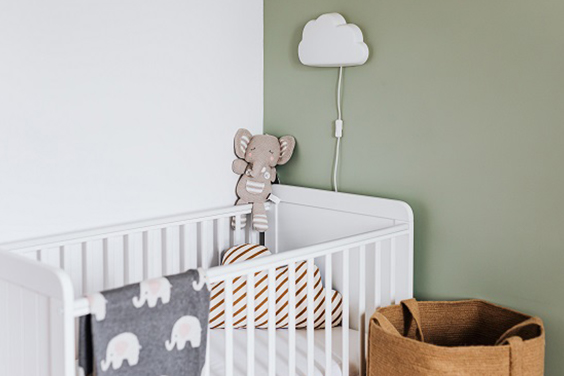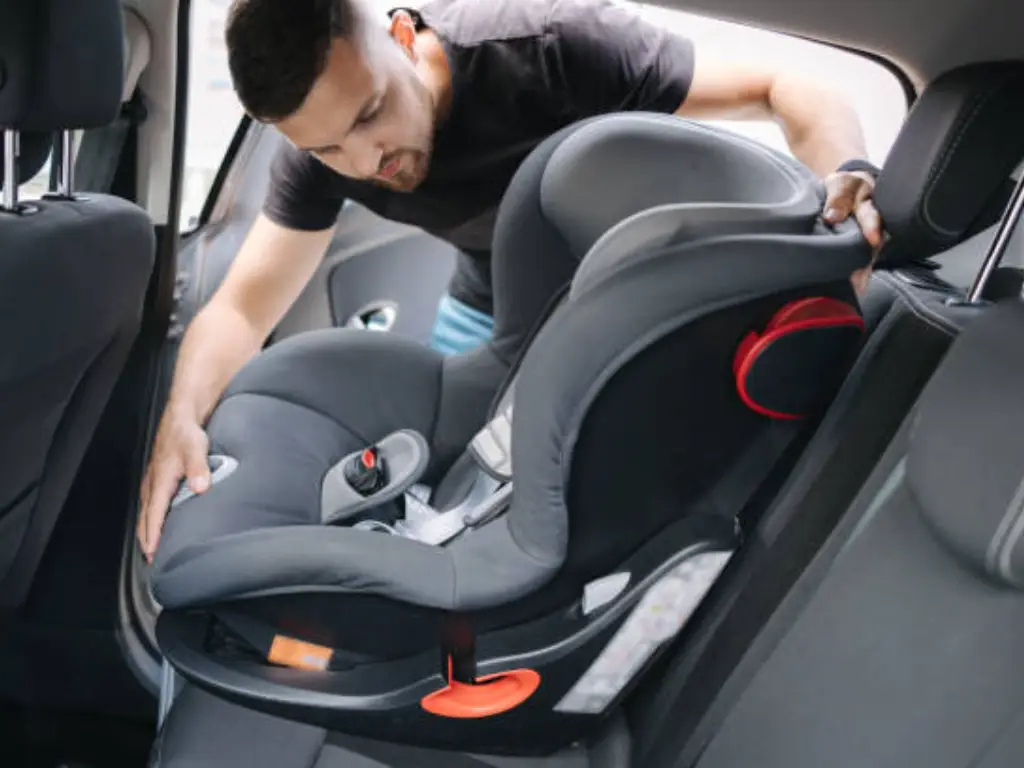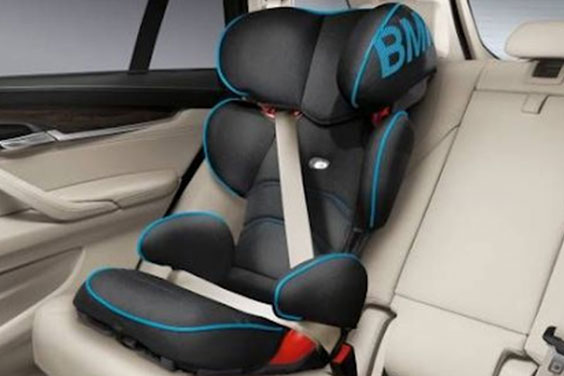
Car safety is of paramount importance when children are in the vehicle, making the quest for the best 5-point harness booster seat a top priority for parents. This device, also known as a car seat with a 5 point harness, is specifically engineered to secure your child in place in case of a sudden accident or harsh braking.
The 5 points – two straps over the shoulders, two over the hips, and one between the legs – create a protective zone, drastically lowering the risk of a severe injury by evenly distributing the forces throughout strong bone structures.
The best booster seat with a 5-point harness ensures safer travel, conforming with the safety standards set by the Highway Safety authorities. Given the higher center of gravity of booster seats compared to other car seats, having a 5-point harness makes them more stable and less likely to tip over, thus being recommended for use in moving vehicles. This is more so if you have multiple car seats installed in the back seat, as it prevents excessive movement between them.
Choosing the Best Materials for Comfort and Durability in 5-Point Harness Booster Seats
Durability and comfort are the two pillars in selecting the best materials in 5-point harness booster seats. Seats with a frame fashioned from robust and lightweight materials like steel or aluminum are the most durable. The booster should also be padded and lined with material that offers a comfortable seat for your child, especially on long car journeys where comfort aids in keeping your child calm and relaxed.
When it comes to seat covers, favored options are those made from durable, easy-to-clean materials, given children’s propensity for spills and accidents. The harness straps, or the five-point harness, should have a tough build to withstand years of use, yet a soft touch to prevent any discomfort or chafing on your child’s skin. Here are some of the best materials to consider for comfort and durability in 5-point harness booster seats:
| Materials to Consider | Explanation | Importance |
| Padded Fabric Covers | Fabric covers that provide extra padding, especially in the seating area and shoulder straps, will add comfort for the child. Look for covers made of breathable, durable fabrics like nylon, polyester, or cotton. Removable covers that are machine washable are ideal for easy cleaning. | 🌟🌟🌟🌟 |
| Foam Padding | Extra foam padding in the seat bottom, backrest, and shoulder straps will provide cushioning and support for the child. Polyurethane or high-density foam is very durable. The more padding, the more comfortable the seat. | 🌟🌟🌟🌟 |
| Breathable Mesh | Mesh fabrics, especially in the backrest and shoulder straps, help keep the child cool and comfortable. Mesh is also lightweight while remaining durable. | 🌟🌟🌟🌟 |
| Steel or Aluminum Frame | A sturdy metal frame provides structural integrity and durability for the car seat. Steel and aluminum can withstand high-impact forces. The frame should also have padded bumpers to prevent discomfort from the metal parts. | 🌟🌟🌟🌟 |
| Buckle and Harness Pads | Padding around the crotch buckle, harness buckles, and shoulder strap hardware will prevent chafing and add comfort for the child. The pads should be securely attached to the straps or buckles. | 🌟🌟🌟🌟 |
| Smooth Edges | All plastic and metal edges should be smooth and rounded to prevent injury to the child or snagging clothing and skin. Smooth edges also provide a more comfortable experience. | 🌟🌟🌟🌟 |
| Adjustable Straps | Padded shoulder straps that can be easily adjusted to fit the child properly are important for both comfort and safety. Straps that are too loose or too tight can be uncomfortable and may not properly secure the child. Multiple strap heights allow the seat to grow with the child. | 🌟🌟🌟🌟 |
Compatibility with Different Vehicles: What to Know When Selecting the Best 5-Point Harness Booster Seat
Getting the right fit seems intuitive, but it’s something many overlook when purchasing a 5-point harness booster seat. The best booster seat with a 5-point harness should, fundamentally, be compatible with your vehicle. The size and shape of the car’s seat, the type of seat belts, and the availability of latch anchors will influence which booster seat will fit well.
While most car seats are designed to be universally adaptable, factors like the car’s seat belt layout might not align perfectly with the booster seat’s design. For example, a vehicle’s seat belt might fall short or be overly lengthy, impacting the safety and security of the seat. Therefore, before buying the best 5-point harness booster seat, it’s important to confirm that it can mount and secure comfortably in your vehicle — the seat belt installation process should be easy and reliable.
Here are the 5-point harness car seat installation tips:
- Choose the Appropriate Car Seat for Your Child’s Size
Before anything else, pay attention to your child’s size. The seat is designed for children weighing 20 to 65 – 85 pounds (depending on the seat) and more than one year old. At 40 pounds, the seat transforms into a booster with the removal of the harness straps. Some models can be used as boosters up to 80 – 100 pounds. Remember to always check the manufacturer’s guidelines as height and weight limits may vary.
- Positioning the Car Seat
Place the car seat in the rear seat of your vehicle, ideally in the center, facing forward. If you drive an SUV or van with three rows, the middle row is best for the car seat. Consult your vehicle’s owner’s manual for specific details regarding car seat placement.
- Installation
You can install the car seat using one of three methods: the lap belt only (usually found in the middle of the back seat), the lap and shoulder belt, or the LATCH system (Lower Anchors and Tethers for Children). Choose the method that best fits your vehicle and car seat specifications. Your vehicle and car seat manuals will provide specific instructions.
- Attaching & Securing the Car Seat
You must ensure that the car seat is securely attached. Refer to the labels on the car seat and the manual for guidance on how to use either the belts or the LATCH system to secure the car seat. The car seat should not move more than an inch side-to-side or front-to-back at the attachment point. It might require another person or a firm push from yourself to tighten the vehicle belt or LATCH attachment properly. Do not forget to attach and tighten the top tether as well.
- Buckling the Child
After installing the car seat, buckle your child carefully. Use the provided harness for children between 20 – 40 pounds (or 65 – 85 pounds, depending on the seat) and more than one year old. Ensure that the harness straps lay flat and snug on the child’s shoulders. The plastic harness retainer clip should be positioned at the child’s armpit level, and the child’s back should ideally be flat against the back of the car seat.
Once your child reaches the maximum weight and height limits for the harness, remove the harness and use the car seat as a belt-positioning booster seat with the lap and shoulder belt of your vehicle.
As highlighted, appropriate selection, correct installation, and usage are foundational in guaranteeing your child’s safety while driving. Make sure you regularly revisit your car seat’s guidelines and check its condition to ensure a safe ride every time.
Maximizing Adjustability for Comfort: The Perks of the 5-Point Harness Booster Seats

The ability to adjust your child’s forward-facing 5-point harness car seat resonates in alignment with their comfort and safety. From harness straps to headrests, adjustability plays a significant role in ensuring the best fit for your child at all times. Some car seats offer a no-rethread harness, which means the headrest and harness can be adjusted without the hassle of rethreading, making it easier to keep up with your growing child.
In the same vein, the seat’s reclined positions can make all the difference, and finding a balance between an alert and relaxed posture contributes to a comfortable seat for your child. This makes for peace and quiet during long journeys, which translates to a more focused and safer driver. The best five-point harness booster seats are designed with polished features like these to make your ride smooth and your child content.
Top Product Reviews: The Best 5-Point Harness Booster Seats Options to Consider
Choosing the right booster seat for your child’s safety can seem daunting, given the many options available on the market. The 5-point harness booster seats are some of the best you can get, providing top-notch safety, comfort, and longevity of use. Here are the top eight 5-point harness booster seat options for you to consider.
Diono Radian 3R All-In-One Car Seat

Features
The Diono Radian 3R All-In-One Car Seat is a 3-in-1 seat that can be used as a rear-facing car seat, a forward-facing seat with a harness, and a high-back booster seat. It supports kids up to 50 pounds in the rear position and goes up until 120 pounds or 10 years age limit. It boasts a slim-fit design for comfort and easy buckling system for convenience.
Why we recommend
We recommend the Diono Radian 3R due to its adaptability from birth to booster stage, easy buckling system, and slim-fit design. However, its extended rear-facing support, which is vital for a child’s safety, sets it apart.
Evenflo Maestro Sport Harness Booster Car Seat
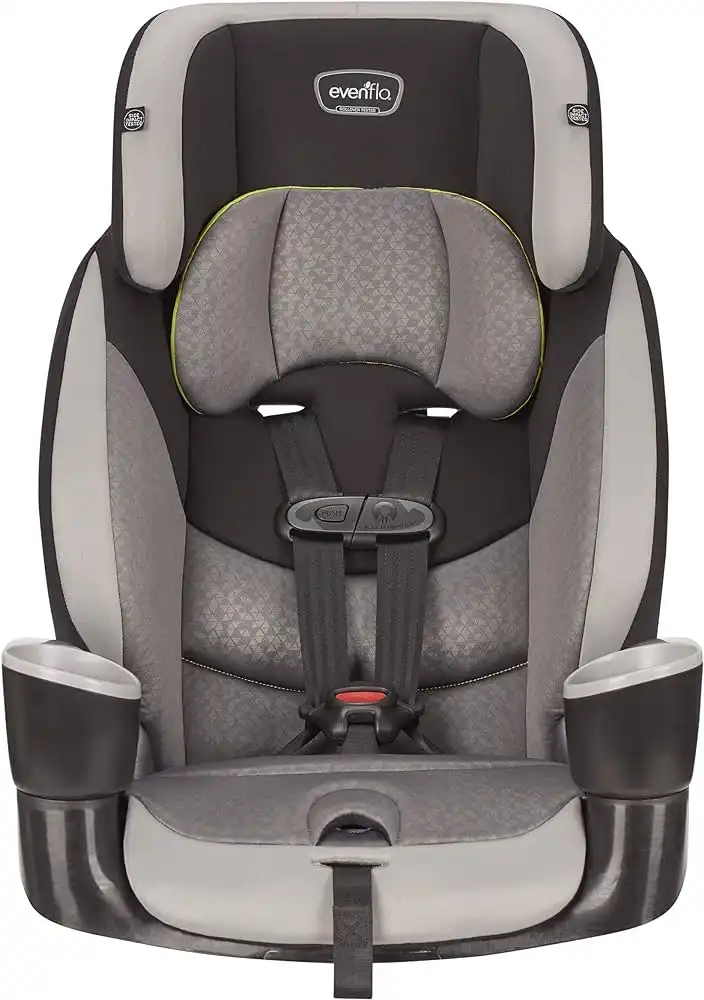
Features
This car seat is adaptable, doubling as a high-back and backless booster. It supports children weighing 22 to 110 pounds. It’s made with premium steel for optimum safety. The seat also includes cup holders for convenience and enhanced comfort for long journeys.
Why we recommend
Apart from the outstanding safety features, we particularly recommend this product because it is machine-washable and the forward-facing belt automatically positions correctly when your child sits in it.
Britax Grow With You Click Tight Harness-2-Booster Seat

Features
Britax’s booster seat provides safe and comfortable seating for kids from 25 up to 120 pounds. The seat contains SafeCell Technology to absorb crash energy and has two-layer protection at the backrest. Coupled with comfort, the seat presents the right blend of support and safety.
Why we recommend
With armrests, a high-strength steel frame, two recline positions, and a crash-absorbing tether and base, Britax’s booster seat provides a safe and comfortable ride, earning our recommendation.
Diono Monterey 2XT

Features
The Diono Monterey 2XT booster seat offers more than just height adjustment; it also adjusts in width, accommodating a child up to 120 pounds. It has a padded headrest, retractable cup holders, and easily transforms from a high back to a backless booster.
Why we recommend
The seat’s high adjustability, comfortable headrest, and easy transformation from high back to backless make it an excellent option for growing children.
Cosco Topside
Features
Cosco Topside is lightweight, minimalist, and excellent for older children. It’s perfect for travel and carpooling, boosting a child up three inches to allow them to buckle themselves in correctly.
Why we recommend
Its simplicity, ease of transport, and low cost, coupled with numerous positive reviews, make the Cosco Topside a simple yet effective booster seat option.
With these options, you’re sure to find the perfect 5-point harness booster seat for your child, catering to their needs for comfort and safety on every journey.
Chicco KidFit ClearTex
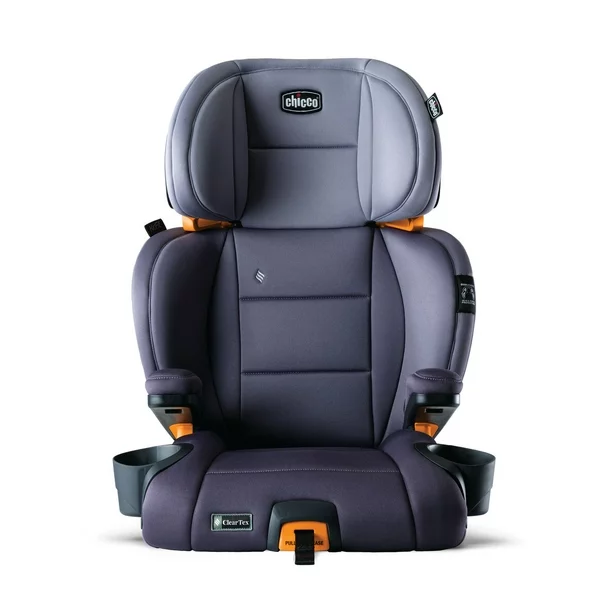
Features
The Chicco KidFit ClearTex is a comfortable and customizable booster car seat. It offers double-foam padding for extra comfort, adjustable height and width as your child grows, and the ClearTex fabric is machine-washable and low in chemical emissions. It’s highly adaptable with 10 height positions when in high back form and a SuperCinch one-pull tightener for easy installation.
Why we recommend
We love the Chicco KidFit ClearTex for its emphasis on comfort and adaptability. The low chemical emission fabric, double-foam padding, and various height positions make it a top pick for a safe, healthy, and comfortable ride.
Graco TurboBooster LX

Features
This popular Graco model is a backless booster suitable for older children. Lightweight and compact, it focuses on convenience while still ensuring safety. Apart from elevating the kid’s height for proper seat belt use, it features an integrated cupholder and a hidden storage compartment.
Why we recommend
The TurboBooster LX continues to impress with its portability and simplicity. Its user-friendly nature allows older children to buckle themselves easily, promoting a sense of independence. Also, the easy-to-clean machine-washable seat pad adds convenience for parents.
Britax Grow With You ClickTight+

Features
The Britax Grow With You ClickTight+ is one of the most versatile and safest booster seats on the market. It starts as a five-point harness seat suitable for children as light as 25 pounds, transitioning to accommodate kids up to 120 pounds as a belt-positioning booster. It features a nine-position easy-adjust headrest and high-quality, removable, and machine washable fabric.
Why We Recommend
We recommend the Britax Grow With You ClickTight+ because of its longevity of use, growing with your child from preschool to elementary school, and its hassle-free install with the ClickTight system. It provides robust safety with three layers of side impact protection and SafeCell Technology, making it highly reliable.
Nuna AACE

Features
The Nuna AACE booster seat stands out for its stunning design and color options. It offers nine-adjustable headrest positions, three seat depths, eight recline positions, and side-impact protection for increased safety. It’s also equipped with a LATCH system for secure installation.
Why We Recommend
The Nuna AACE booster seat is highly recommended for its customizability, greenguard gold certified fabric, expanding design as your child grows, plus an appealing look that kids will love.
Choosing the right 5-point harness booster seat for your child involves considering your child’s needs, the car’s compatibility with the seat, your lifestyle, and budget. By reviewing the top options on the market, you increase your chances of finding the perfect seat that ensures your child’s safety and comfort during every car ride.
UPPAbaby Alta

Features
The UPPAbaby Alta distinguishes itself with a very high seatback. It has a height that extends up to 33 inches, with seven adjustable headrest positions. It features a seat belt-routing system, providing a secure ride for your child. The removable seat fabric and cup holder make it easy to keep clean.
Why We Recommend
We love the UPPAbaby Alta for its high adjustability. The taller backrest specifically caters to kids with a long torso, ensuring they remain comfortable and secure. In addition, the belt-routing system helps guide the seat belt to the correct positions, making this a solid choice safety-wise.
What are the weight and height requirements for using a 5-point harness booster seat?
Knowing when your child can transition from a harnessed car seat to a 5 point harness booster seat is key.
Remember, neither too early nor too late is the way to go. The switch mainly depends on your kiddo’s height, weight, and age. While the various brands and their models may have slightly different specifications, generally, a 5-point harness car seat can safely secure kids who are between 40 and 65 pounds.
Once your older kids hit the weight limit of their forward-facing 5 point harness car seat, that’s your cue to consider a booster seat. But put the brakes on! You also have to consider your child’s height, because let’s face it, kids grow at their own pace. The height limit for kids to graduate from the harness seat is usually when their shoulders are above the topmost slots for harness straps.
And here’s the thing – you can’t let their age dodge your attention. Most highway safety experts will recommend waiting until they’re at least 5 before shifting to a booster. Why? Not all four-year-olds mature at the same rate, and some might need more time before transitioning safely to a 5 point harness booster seat.
How do I know if my child has outgrown the 5-point harness booster seat?
Determining if your child has outgrown their 5-point harness booster seat involves a few simple checks:
- Height: Most booster seats have a height limit. If your child’s shoulders are above the highest harness slots, or the tips of their ears are higher than the top of the car seat, they may have outgrown the seat. Always check the product manual for height requirements.
- Weight: Each booster seat model also has a weight limit. If your child’s weight surpasses the seat’s limit, it may no longer provide optimal protection.
- Seat Strap Position: For a 5-point harness booster seat, the harness straps should ideally rest at or above your child’s shoulders. If they are below, it’s a sign your child has outgrown the seat.
- Fit: The child’s bottom should be flat against the bottom of the seat and their back should be flat against the back of the seat. If they cannot sit this way, they’ve likely outgrown the seat.
- Comfort: Comfort matters a lot. If your child seems uncomfortable, complains about the seat, or consistently struggles to get comfortable, it can mean they’ve outgrown the seat.
- Manufacturer’s Guide: Different manufacturers have different guidelines so checking the specific booster seat manual will provide the exact time to transition.
Always follow the manufacturer’s recommendations regarding the weight and height limits of the car seat. If your child has outgrown their 5-point harness seat, you may need to transition them to a high-back booster or backless booster seat. A professional child passenger safety technician can provide guidance if you’re unsure about the correct seat for your child’s size and age.
Harness Tightness: An Important Safety Factor in Choosing the Best 5-Point Harness Booster Seat
Think of a 5-point harness booster seat as a high-five for safety but only when the harness is just right. Too loose, and the child could get hurt during a sudden halt. Too tight, and you might have an irritable child complaining throughout the journey.
Harness tightness is undeniably one of the most critical safety features when opting for the best 5-point harness booster seat. When correctly adjusted, a tight harness restricts unnecessary movements and keeps your child securely fastened to their seat, significantly reducing the risk of injury or ejection during a crash.
Parents should check the harness tightness every time their child is buckled into the car seat. Here’s how to ensure correct tightness:
- Pinch Test: After fastening the harness, try to pinch the strap vertically. If you can pinch the webbing together, the harness is too loose. The harness strap should lie flat with no slack.
- Chest Clip Positioning: The chest clip is a crucial aspect of harness tightness. It should be positioned at armpit level to keep the harness straps secure on your child’s shoulders. If the chest clip falls too low, it could potentially cause abdominal injuries in an accident.
- Avoid Bulky Clothing: Bulky clothing, like winter coats, can create an illusion of a snug-fitting harness. However, during a crash, the padding compresses, leaving only slack in the harness. To prevent this, dress your child in thin, snug layers and drape a blanket over them to keep them warm.
- Comfortable Tightness: Always check for comfort. The harness should be snug, but it should not press too hard into your child’s shoulders or cut into their skin.
Remember, as your child grows, re-check the harness adjustment frequently. However, even the tightest harness can’t ensure safety without correct car seats installation. Make sure the car seat is installed tightly enough that it moves less than an inch side-to-side or front-to-back when pulled at the seat belt path.
How Often Should You Check the Harness Tightness?
You should ideally check the harness tightness every time you place your child in their seat. Children can grow rapidly, and what was a perfect fit a week ago may not be the same now. Also, changes in clothing thickness with different weather conditions can affect the harness’s snugness.
Aside from these consistent checks, make sure to do a more thorough evaluation of the harness and other car seat components approximately once a month. Look for signs of wear and tear on the straps, inspect buckles and adjustors for proper functioning, and ensure nothing is obstructing the straps and buckles.
Remember that a correctly adjusted harness is a crucial element in protecting your child in the event of an accident. It’s a small task that plays a huge part in your child’s safety.
Maintenance Tips for Ensuring Longevity of the Best 5-Point Harness Booster Seats
Great! You’ve brought the best 5-point harness booster seat home. But is that it? Nope, there are few more miles to go. Like your vehicle, maintaining your child’s booster seat is crucial for longevity and safety. It’s like having a pet, you’ve got to take care of it, or it won’t be at its best! Check out the seat pad regularly.
A sturdy, yet comfortable seat pad is worth a shout-out, right? So, regular clean-ups, using the right cleaning agents, and instant action on spills will keep the seat fresh and welcoming. While on the topic of the harness, remember that it’s not just about the perfect snugness.
Every once in a while, ensure that the harness straps and the clips latch and unlatch smoothly. Lastly, don’t forget to check out for wear and tear. It may seem like the booster seat 5 pt harness is still in top form, but invisible cracks or strains might be lurking beneath the surface. Regular inspections and sticking to the manufacturer’s guidelines ensure your 5 point booster seat stays sturdy and reliable.
Can a 5-point harness booster seat be used in all types of vehicles?
Speaking of child outgrows, can 5-point harness booster car seats be used in assorted vehicles? From the cozy hatchback that proudly sports a “Baby on Board” sign to the roomy SUV that’s ready for family road trips, the response in most cases is – yes! Yet, remember the golden rule of thumb.
The best 5 point harness booster car seat is the one that fits your child and your vehicle like a well-tailored glove. Different vehicles have unique designs and seat belt configurations, yet most car seats are intended for universal application.
However, exceptions exist. Some vintage models or sports cars with shorter seat squabs might not accommodate the 5 point harness car seat for older children. That’s why cross-checking your car’s specifications with the car seat lady for the best boosters could be a prudent move.
Conclusion: Making the Final Selection for the Best 5-Point Harness Booster Seat for Your Child’s Safety
Navigating the world of 5-point harness booster seats can feel like dipping your toes in a sea of options. But with the right know-how, you’re all set to make a splash and saunter out with your optimum choice.
Factor in your child’s size, compatibility with your vehicle, and the ideal comfort & durable materials in your decision-making process. Stay on top of maintenance, and you’re all set for safe journeys ahead with a booster seat that’s waving the flag of safety and comfort in equal measure!


